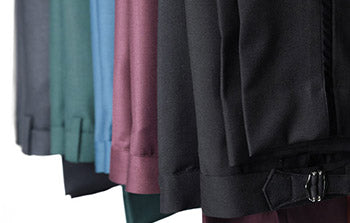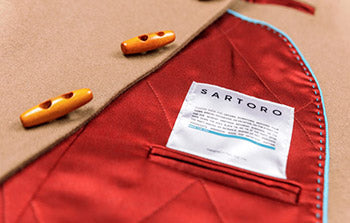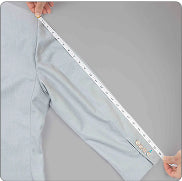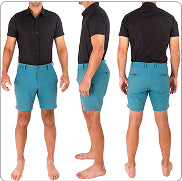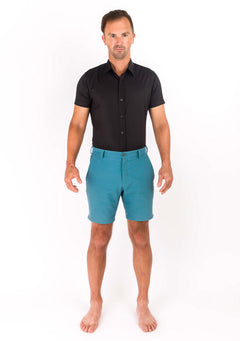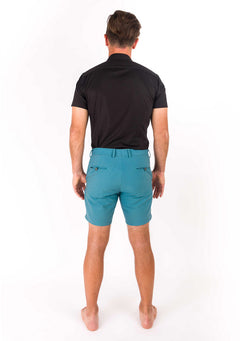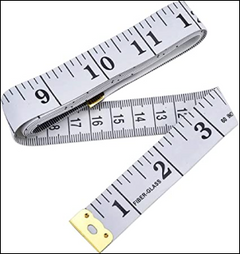
Can You Iron A Suit Jacket? Here’s The Right Way
Contents
- Assess Your Suit Fabric: Is Ironing Safe?
- When Ironing A Suit Jacket Makes Sense
- Gathering Your Tools: What You Need To Iron A Suit Jacket
- Step-By-Step: How To Iron A Suit Jacket The Right Way
- Iron vs. Steamer: What’s Safer For Your Jacket?
- Post-Ironing Care: Protecting Your Newly Smoothed Suit
- Common Mistakes To Avoid When Ironing A Suit Jacket
- Final Thoughts
- Frequently Asked Questions About Can You Iron A Suit Jacket?
Key Takeaways:
- Fabric First: Always check your suit jacket's fabric type and care label to choose the correct iron temperature and approach. Wool needs gentle heat, while linen and cotton can handle more but benefit from ironing inside-out.
- Protection is Key: Always use a pressing cloth between the iron and suit fabric to prevent shine marks, scorching, and damage to delicate fibers.
- Steam is Your Friend: Steaming is safer and gentler than direct ironing for most wrinkles. Reserve ironing for stubborn creases, and always apply light pressure with controlled steam.
Let’s be honest—wrinkles happen. Maybe it’s from a long flight, maybe it’s from the way you stored it. Either way, your suit jacket needs a reset. The big question: Can you iron it?
You can, but only if you’re doing it right.
A suit jacket isn’t built like a dress shirt. It’s layered, shaped, and detailed, and its structure doesn’t respond well to direct heat. Press it the wrong way, and you risk flattening lapels, leaving shine marks, or worse, permanently altering the fit.
At Sartoro, we’re all about giving you the tools to care for your wardrobe as it deserves. This guide breaks down how to iron a suit jacket properly, when it’s better to steam instead, and how to keep your custom fit looking as sharp as it did on day one.
Assess Your Suit Fabric: Is Ironing Safe?
Before you reach for the iron, it’s crucial to recognize that not all suit fabrics respond the same way to heat and steam. Understanding your jacket’s fabric composition ensures that your effort delivers a crisp, polished look, never accidental damage. Here’s how to approach the task with discernment and care.
Wool: Classic, But Sensitive
Wool, prized for its luxurious drape and breathability, is a mainstay of high-quality suiting. However, it’s also sensitive to direct, excessive heat. High temperatures can scorch fibers, create shine, or even warp the fabric’s natural weave.
When ironing a wool jacket, always set your iron to the “wool” or low/medium heat setting and use a pressing cloth as a protective barrier. This is especially important when caring for darker tones like a black suit jacket, where heat damage can be more visible.
Linen And Cotton: Lightweight, Yet Demanding
Linen and cotton suits offer comfort and a cool aesthetic, perfect for warmer climates or more relaxed occasions. Although these fabrics are more tolerant of heat than wool, linen is particularly vulnerable to creasing and can lose its shape if over-ironed. Cotton, while robust, may develop a glossy finish when exposed to a hot iron. Always iron these fabrics inside-out, and use a burst of steam to coax out stubborn wrinkles without compromising the crisp texture.
Blended Fabrics & Synthetics: Proceed With Caution
Modern suits often incorporate blends, mixes of natural fibers with synthetics like polyester, viscose, or spandex, to enhance stretch, durability, or wrinkle resistance. These blends require extra vigilance: synthetic fibers can melt or deform under high temperatures. Always check the care label, start on the lowest possible setting, and gradually increase heat if needed, using a pressing cloth between the iron and fabric.
When Ironing A Suit Jacket Makes Sense
Even the most meticulously crafted suit jacket isn’t immune to the occasional wrinkle or stubborn crease. However, knowing when it’s appropriate to reach for your iron can preserve your garment's tailored silhouette and luxury feel. Ironing a suit jacket isn’t always taboo; understanding the ideal circumstances ensures you maintain that sharp, “ready for anything” appearance without compromising the fabric or fit.
Spot-Treating Persistent Wrinkles
Your custom men's suit jacket might emerge from the closet looking crisp, but travel, storage, or even unboxing a new piece can introduce unsightly wrinkles. Lightly ironing may make sense when you notice particular problem areas, think crinkled lapels from transportation, or shallow creases near pockets that won’t ease out on their own. Focused, gentle ironing helps you restore smoothness, letting each detail of your jacket stand out as intended.
After Steaming Doesn’t Do The Trick
Steaming remains the gold standard for routine suit care, reviving natural fibers without direct contact and risk of shine. Still, some stubborn wrinkles persist even after a thorough steaming. In these cases, careful ironing (with a pressing cloth) can coax out lingering folds, returning the jacket’s surface to its original, sophisticated state.
Prepping For A Major Occasion
Special events demand perfection. If you’re due to attend a major business presentation or a milestone celebration, you want your suit to look impeccable from every angle. When a light steam doesn’t deliver, strategic ironing can ensure the jacket holds its shape and drapes flawlessly—empowering you to own the room with confidence and flair.
Gathering Your Tools: What You Need To Iron A Suit Jacket
When preparing to iron a suit jacket, having the right tools is essential to achieve a crisp, polished finish and preserve the unique fabric and structure of your jacket. Precision starts with the details, and with the right equipment, you can express confidence and creativity in every press.
Iron With Adjustable Steam Settings
A high-quality iron should offer adjustable steam settings. These allow you to tailor the amount of heat and moisture, ensuring you won’t scorch delicate fibers or wrestle with stubborn creases.
Pressing Cloth
Always use a thin, clean pressing cloth, such as cotton or muslin. This barrier sits between the iron and your jacket, preventing shiny marks, burns, and undue stress on the fabric while keeping your finish refined and professional.
Ironing Board Or Flat, Padded Surface
Opt for a sturdy ironing board with a padded cover to provide a smooth, even surface. If you lack an ironing board, a thick towel spread over a flat, heatproof table can suffice, just make sure it’s wrinkle-free and stable.
Spray Bottle With Water
A fine-mist spray bottle filled with clean water allows you to dampen stubborn wrinkles gently without soaking the fabric. This technique adds just enough moisture to ease outlines while safeguarding the texture and drape of your jacket.
Sleeve Board Or Tailor’s Ham (Optional)
For those who value meticulousness, a sleeve board or tailor’s ham helps you press sleeves, shoulders, and curved areas precisely. These tools prevent hard creases and maintain the garment’s natural contour.
Step-By-Step: How To Iron A Suit Jacket The Right Way
Even the sharpest suit jackets can lose their crisp lines over time. But with the right technique, you can restore their refined silhouette, without compromising luxury or craftsmanship. Follow these steps to iron your suit jacket with precision and confidence.
Prepare Your Tools And Workspace
Start by gathering a steam iron (preferably with adjustable heat), a pressing cloth or clean white cotton towel, a sturdy ironing board, and a spray bottle of water. Set your iron to the appropriate temperature for your jacket’s fabric, usually a low or wool setting for most suits.
Inspect And Prepare The Jacket
Empty all pockets and gently shake out the jacket to loosen any dust. Place the jacket inside-out on the board and check for stains or marks, as heat may set them permanently.
Dampen And Protect The Fabric
Lay the pressing cloth between the iron and the jacket to shield the delicate fabric from direct heat. Lightly spritz the area with water from your spray bottle; this will help release wrinkles without risking shine or scorch marks.
Begin With The Sleeves
Slip one sleeve over the narrow end of the board, smoothing the fabric. Press with the iron gently, with downward strokes, never leaving the iron in one place for too long. Use steam as needed, and flip the jacket to repeat the process on the other sleeve.
Press The Body In Sections
Next, move to the body of the jacket. Start with the front panels, repositioning the jacket to ensure flat contact. Guide the iron slowly downward, always keeping the pressing cloth in place. Continue to the back panel, again pressing with care and avoiding any structured seams or padded areas.
Attend To The Lapels And Collar
Open the lapels and gently press them flat, then fold back along the natural roll to retain their shape. The collar may be ironed carefully from the underside only; avoid flattening the top, which can destroy its three-dimensional character.
Let The Jacket Cool And Hang
After each section, allow the fabric to cool before moving to the next, preventing new wrinkles. Once finished, hang the jacket immediately on a wide, shaped hanger to help it retain its custom contours and let any remaining moisture evaporate naturally.
Iron vs. Steamer: What’s Safer For Your Jacket?
Choosing the right tool, a traditional iron or a modern garment steamer, can make all the difference in smoothing out wrinkles or refreshing your blazer between wears. Each approach has its strengths, and knowing when and how to use them empowers you to maintain the true luxury of your wardrobe.
The Iron: Precision And Power
Ironing has long been the go-to method for flattening severe wrinkles and achieving razor-sharp creases. With a regulated temperature and the right technique, an iron can restore your jacket’s tailored structure. However, there’s a risk: direct contact and high heat can scorch delicate fibers, create unwanted shine, or even permanently crease areas like lapels or pockets. Always use a pressing cloth and keep the iron moving; never let it linger on one spot.
The Steamer: Gentle Yet Effective
A garment steamer delivers wrinkle-releasing steam without direct interaction with the fabric. This method is gentler, as it won’t crush the natural shape or alter the texture of wool, linen, or cotton blends. Steamers are ideal for refreshing jackets between wears, removing light wrinkles, and revitalizing the drape without risk of shine or damage. Simply hang your blue suit jacket and let the steamer do the work; no pressing is required.
Which Should You Use?
A steamer is your safest bet for daily maintenance and quick touch-ups, especially for structured garments. Reserve the iron for more stubborn creases and always proceed with caution, employing proper technique to preserve your jacket’s luxury and shape. The right choice depends on your needs, but both tools, used correctly, can help you maintain a commanding presence wherever you go.
Post-Ironing Care: Protecting Your Newly Smoothed Suit
Ensuring your suit jacket remains sharp and pristine after ironing requires as much attention as your initial pressing technique. Following thoughtful care steps will preserve those crisp lines and the garment’s luxurious feel, empowering you to express sophistication at every occasion.
Hang With Intention
The moment your suit jacket cools, transfer it straight onto a wide, contoured hanger. This supports the shoulders and prevents awkward creases or dimpling. Avoid wire hangers, they can distort the jacket’s natural shape and undo your careful work.
Give It Breathing Room
Don’t crowd your freshly-ironed jacket in a cramped closet. Allowing space between garments helps fabric fibers relax and ensures airflow, which deters wrinkles and maintains fabric integrity. If you’re traveling, opt for a quality garment bag to buffer against scrunching and sudden folding.
Brush And Steam For Final Touches
A gentle suit brush removes any lingering lint or dust, keeping your jacket photo-ready. If subtle wrinkles form during wear, employ a handheld steamer instead of another round with the iron. Steaming is gentler on delicate materials and revives that fresh-from-the-press look without risking shine or fabric damage.
Common Mistakes To Avoid When Ironing A Suit Jacket
Ironing a suit jacket can elevate your appearance—or risk diminishing the garment’s elegance if not done properly. Understanding the most frequent missteps will protect your investment and ensure your look stays sharp, sophisticated, and unmistakably personal.
Applying Too Much Heat
Wool, linen, and cotton blends used in luxury jackets are exquisite but sensitive. Setting the iron too high can scorch fibers, cause shiny spots, and even permanently damage the fabric. Always use the lowest effective heat setting recommended for your suit material and test on an inconspicuous area first.
Ironing Directly On The Fabric
Direct contact between a hot iron and the jacket’s surface can lead to unsightly marks, flattened textures, and, in some cases, color changes. Using a clean, thin pressing cloth as a barrier protects the delicate weave and preserves the piece’s refined finish.
Ignoring The Jacket's Structure
A suit jacket isn’t built like everyday clothes. The canvas, shoulder pads, and intricate inner construction require special handling. Avoid pressing too hard or ironing over structured areas like lapels and shoulders, doing so can distort the silhouette and ruin the garment’s crisp lines.
Overusing Steam
While a burst of steam is helpful for stubborn wrinkles, over-steaming can saturate the fabric, weaken its shape, and lead to water spots. Keep the steam light and controlled, holding the iron just above the fabric when addressing creases.
Skipping A Proper Surface
Ironing on an uneven or soft surface risks creasing and warping the jacket. Always use a firm, padded ironing board or a dedicated pressing surface designed for tailored garments to maintain the jacket’s shape and sharp details.
Avoiding these common pitfalls ensures your suit jacket remains a canvas for self-expression, flawless, refined, and uniquely yours.
Final Thoughts
A well-maintained suit jacket is more than just a wardrobe essential; it’s a statement of precision, confidence, and personal style. While ironing a suit jacket is possible, it demands care, proper tools, and attention to fabric details. Following the appropriate technique and avoiding common mistakes, you can keep your jacket looking immaculate without compromising its structure or luxury feel. Whether prepping for a milestone event or refreshing after travel, knowing when and how to press makes all the difference in maintaining that signature Sartoro silhouette.
Read also:
Frequently Asked Questions About Can You Iron A Suit Jacket?
Can you iron a suit jacket at home?
You can iron a suit jacket at home, but it requires care and attention to detail. With patience and the right method, at-home ironing can help maintain the sharp, personalized look of your custom Sartoro jacket. Always prioritize gentleness to protect the luxury materials and meticulous craftsmanship.
What is the correct temperature to iron a suit jacket?
The right temperature depends on the fabric. For wool, a medium heat (around 140°C/285°F) with steam is best. For cotton or linen blends, you can use a slightly higher setting. Always check the care label and use a pressing cloth to prevent direct contact between the iron and the fabric.
Is it safe to iron all materials of suit jackets?
Not all materials are created equal. Most wool, cotton, and linen jackets can be ironed with care, but delicate fabrics, like silk or blends with synthetic fibers, require extra caution or alternate methods. When in doubt, test on an inside seam first or consult care guidelines to protect your custom-made piece.
Can you use a regular ironing board for suit jackets?
Yes, a regular ironing board is suitable. For best results, use a sleeve board or roll up a towel to place inside the sleeve; this preserves the shape of the jacket. Always ensure the jacket is laid flat and smooth to protect the custom lines and structure tailored to your body.
How do you avoid shining the fabric when ironing a suit jacket?
Shine occurs when direct heat compresses fabric fibers. To prevent it, use a pressing cloth (like a clean cotton towel or handkerchief), lightly mist the area with water, and use the steam function. Move the iron gently, without pressing too hard, to preserve the fabric’s natural finish.
What are alternative ways to remove wrinkles from a suit jacket?
If you’d rather avoid ironing, try steaming your suit jacket, a garment steamer is ideal. Hanging the jacket in a steamy bathroom can work in a pinch, too. These methods relax fibers gently, preserving the jacket’s fit and appearance.





